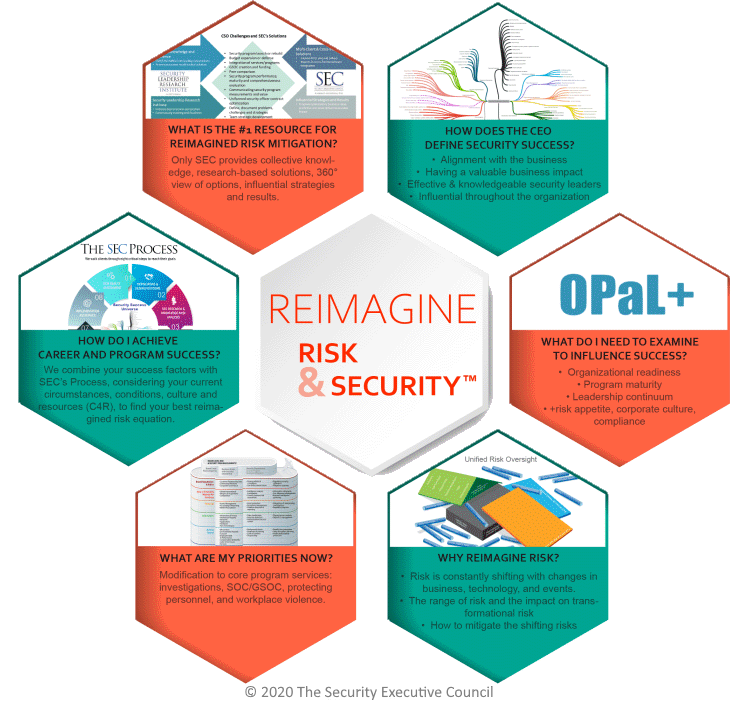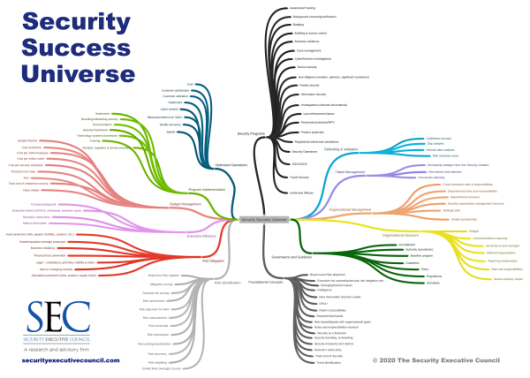A recent SEC Security State of the Industry event for
Tier 1 leaders explored how practitioners must reimagine risk and security to envision a post-COVID future.
Here are some of the highlights of the discussion, which featured Bob Hayes, SEC Managing Director; Kathleen Kotwica, EVP and Chief Knowledge Strategist; Dan Sauvageau, Emeritus Faculty - Executive Influence; Francis D'Addario, Emeritus Faculty - Strategic Innovation; and Jim Hutton, Emeritus Faculty - Strategy and Leadership Development.
Security Success
If we want to adapt to an uncertain future, we first must look at what we're doing now, why and how we're doing it, and then examine whether that model matches the reality we are facing.
It's useful to first revisit how we achieve security success in any environment.
- Success requires you to recognize Security's current conditions, culture, circumstances, and resources (your C4R). You may have great plans, but if you don't consider the C4R, you'll likely fail to gain traction.
- Successful leaders develop a compelling story for Security. They set expectations and give examples of what success looks like. They use it as a tool to gain strategic input. Now, more than ever, our story is important; however, it is likely to change due to the current environment.
- We need to understand the entire realm of Security. The SEC has outlined the Universe of Security Success (see the figure below). This is the accumulation of 15 years of research and collaboration with thousands of leading security practitioners. Not all elements in this universe are necessary for everyone. The trick is to find the elements that will provide your organization the most value.
Why Reimagine Risk and Security Now?
A worldwide pandemic of this scale has not been seen in our lifetime. It has produced a tremendous amount of change. Organizations and security departments clearly have their hands full reacting to twists and turns. But we need take the time to be prepared for an alternative future state.
Your company today is not the same company it was last year. A recent
McKinsey report claimed that a majority of businesses have changed how they go to market since the pandemic started.

Reimagining risk and security means
- recognizing risk shifts based on current events, company changes, social, economic, and political changes.
- re-assessing your organization's security risks and revisiting your programs, services, and mitigation strategies informed by these changes.
- prioritizing any modified plans while aligning with the organization's new directions and goals.
Security needs to look ahead. What may permanently change, and how will core security programs adapt in a
VUCA (Volatile, Uncertain, Complex, and Ambiguous) world?
Executives are Looking for Opportunities
According to
McKinsey's Innovation Through Crisis survey, most executives see new opportunities for growth right now, but few feel confident they'll be able to harness them. Security can be a partner in this endeavor. Opportunities exist in moving fast and taking on more risk. Security can help in the reimagining process by doing what we do - objectively articulating the potential security risks that may derail new growth.
Security must adapt its core programs to meet the company's new requirements and the need to leverage new opportunity.
Risks from Continued Work from Home
The continuing work from home model brings both physical and Information risk.
On the information protection side:
- Employees working from home are unlikely to use safe practices on their own.
- A CyberArk study shows that 60% of remote workers use unmanaged BYOD to access company assets; 89% use the same password across platforms; and 57% insecurely store passwords in browsers.
- Vendors are also using remote workers.
- Are you comfortable with their workers' remote security?
- Do you trust they will contact you in the event of a breach?
- Do they have the capacity to meet your security requirements at all?
- Insider threats
- In the brick and mortar environment, security often gets tips on insider risk from coworkers who see red flags. In a work-from-home environment, that resource is lost. How do we replicate that informal environment in a remote world?
On the physical security side:
- Economic forecast shows potential increase in crime; should companies install home security systems to keep staff and assets safe?
- Hiring concerns. The usual intuitive behavioral signals that occur during in-person interview will be harder to assess on video meetings. Perhaps we will be able to use automated behavioral analysis applications?
- What will access control, video surveillance or medical procedures look like? How do we accomplish that in a work from home environment? Or can we?
- The security control center (SOC) or GSOC is one tool that could help you reimagine some risk processes. Will it take calls from all employees? Will the GSOC take on situational awareness, coordinate responses, or send individualized advisory information to help remediate potential issues?
- Investigations - how will we handle hostile interviews, equipment recovery, or searches for material or information? Do employees sign a condition of employment document that ensures Security can come and get the equipment if the employee does not return it?
- Risk mitigation is the responsibility of many functions across the organization. Working from home will make cross-functional teams even more important for coordinating handling events. This may also include updating or developing new policies.
At-home employees continue to share responsibility for security. It's important to communicate that responsibility and articulate exactly what they need to do to manage security in their workspace. It's also important to solicit their feedback. Companies are pivoting -from auto parts to ventilators, distillers to sanitizers - and those solutions may be coming from the shop floor. Find out what employees are thinking and what they need. Be culturally relevant. Use apps to let them provide input and feedback about their own safety, security and health.
Further Resources
For more information about some of the foundational concepts shown in the Reimagine Risk and Security image above:
Unified Risk Oversight
Board-Level Risk
OPaL+
Program Continuums
Security's Value Potential
Maturity Model
You can download a PDF of this page below:


